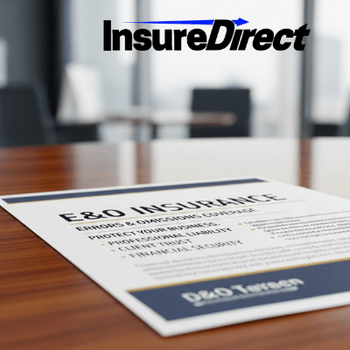When I first started out in financial advising, I thought confidence and spreadsheets would carry me. Spoiler: nope. The real world of money and clients—it’s messy, unpredictable, and sometimes, even if you do everything “right,” someone still says you did it wrong.
Now, E&O insurance—Errors and Omissions, or “professional liability” (which sounds fancier but means the same)—is one of those things you don’t think about until you really need it. I didn’t. And that almost ruined me.
What even is this E&O thing?
So basically, it’s an insurance that picks you up when somebody says, “hey, your advice cost me thousands, and I’m taking you to court.” And here’s the kicker: doesn’t even matter if you actually messed up. The claim alone can bleed you dry.
I’m not kidding: lawyers, paperwork, “he said she said” arguments. It’s a circus. If you don’t have coverage, you’re paying all that yourself.
Some folks call it “malpractice insurance for finance people.” Honestly, that’s pretty accurate.
Why it matters (from someone who didn’t know better)
Clients trust you with money—sometimes their entire retirement. That kind of responsibility is a loaded gun sitting on your desk. One slip, one bad call, or heck, even a misunderstood email… suddenly you’re the villain in their financial story.
First: lawsuits. I used to think, “That won’t happen to me, I’m careful.” Wrong. It can happen even if you’re perfect.
Second: reputation. One lawsuit, rumors start flying. Doesn’t matter if you win in court. Damage is already done.
Third: honest mistakes. Humans aren’t robots (obviously), and numbers? They hide traps. Misplacing a decimal can look like fraud to an angry client.
Fourth: some clients straight up require you to have this insurance before they’ll work with you. Learned that one late.
Last: peace of mind. The kind that lets you sleep at night instead of staring at the ceiling thinking about subpoenas.
What’s covered (and what’s not)
My policy covered “oops moments” like:
A client says you gave bad investment advice.
Forgetting to mention a risk that later explodes in their face.
Leaving out info that you thought wasn’t critical but turns out it was.
Defending yourself in court when someone accuses you of misrepresentation (yep, had that one).
But let me be clear: E&O isn’t some magic “get out of jail free” card. Fraud? Intentional lies? Criminal acts? Nope. You’re on your own there, buddy.
Story time (aka why I caved and bought it)
One client—let’s call him “Mr. R”—wanted aggressive growth. We talked risks, he nodded, seemed fine. Market dipped, his portfolio tanked, he claimed I never warned him. Suddenly, I’m the bad guy in his life story.
That lawsuit dragged for almost a year. Do you know how much defense attorneys cost? Don’t google it, you’ll faint. Without my E&O policy, I would’ve been toast. Completely broke. Instead, insurance paid most of it, I walked out bruised but alive.
Lesson: don’t wait until you’re in the fire to buy the extinguisher.
What does this insurance cost, anyway?
Depends. I pay around two grand a year, but I’ve seen policies for under a thousand and others hitting five grand easy. Factors:
How long you’ve been in the game.
Size of your client base.
Your state (yep, location changes rates).
Whether you’ve been sued before. Insurers hate repeat drama.
Point is, it’s not cheap, but neither is losing your shirt in a courtroom.
Picking the right policy
I learned the hard way, don’t just click the first link on Google. Things to check:
Coverage limits – if your clients are rolling millions, don’t cheap out on a small policy.
Exclusions – fine print hides nasty surprises. Read it or pay later.
Deductible – the “ouch money” you cough up before insurance kicks in.
Provider rep – not every insurer knows financial advising. Pick one who does.
Tail coverage – protects you after you retire, because lawsuits don’t check calendars.
How I try not to use my insurance
Insurance is the safety net, but I’d rather not fall. So I:
Write everything down (emails, notes, signatures—cover yourself).
Speak in plain English, not financial riddles.
Tell clients the risks at least twice, so they can’t say I didn’t.
Review portfolios regularly instead of letting them collect dust.
Keep an eye on compliance like my career depends on it (because it does).
Wrapping this up
If you’re a financial advisor and you don’t have E&O insurance… you’re walking across a highway blindfolded. Seriously. I thought I was careful enough, but reality humbled me. Now, I see it as part of the job, like paying taxes or updating licenses.
It’s not about expecting to screw up. It’s about being realistic that sometimes, even when you don’t, somebody swears you did. And that fight? You don’t want to do it alone.
Looking for the best insurance coverage? InsureDirect has you covered. Getting a home insurance quote is simple and fast—just visit our website or reach out to our corporate office:
InsureDirect.com
Corporate Home Office
618 South Broad Street
Lansdale, Pennsylvania 19446
Email: contact@insuredirect.com
Phone: (800) 807-0762 ext. 602
Protect your home and enjoy peace of mind with top-quality insurance from InsureDirect. Because your home deserves the best protection possible.

